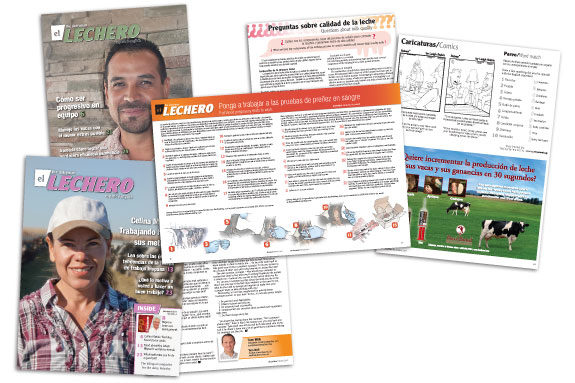About three years ago, a visitor to the Michigan State University Extension office in Saint Johns happened to mention a beginner English class taught at his church. Many of the students were Hispanic dairy workers who wanted to learn English as a second language. MSU Extension dairy specialist Faith Cullens thought she had the perfect tool for the class: A bilingual magazine called El Lechero, then published as an insert in Progressive Dairyman.
The magazine was chocked full of useful articles about dairy herd management, milking practices and industry trends – all printed in both English and Spanish. The publication even had comics and an English-Spanish word match puzzle.
Cullens, a Progressive Dairyman subscriber, gave the man a stack of El Lechero magazines to take back to his church.
She has found the publication useful in her own work.
“I’ve set several articles aside in my files,” she says. “What I like about it is that I can read it in English.”
The stack of El Lechero magazines eventually ended up in the hands of Patsy Coffman, who teaches ESL classes at the church as a volunteer.
“We do enjoy it,” Coffman says of the bilingual publication.
It helps the dairy workers in the class learn words directly related to their work.
“It’s kind of like a little English lesson,” she says. “The topics are really relevant to what they’re doing. In class we like to talk about people’s work and what they do every day.”
Recent El Lechero articles have dealt with topics such as early disease detection, how to improve lame cow management and Hispanic workforce trends. It’s now a separate stand-alone publication. Click here to to read more about subscribing to El Lechero magazine.
Coffman liked it so well that she arranged for a subscription. Several copies of the magazine now arrive at the church every month.
“The students look forward to it,” she says. “When it comes, we stop what we’re doing and take a lesson from it.”
The church now offers several different ESL classes based on proficiency level, and all make use of the bilingual publication.
About 30 years ago, Coffman, a substitute teacher, started taking a few Spanish classes at a local community college.
“I realized people ought to know more than one language,” she says.
Later, as a missionary to Mexico, she taught English as a second language for a year. Still, she didn’t consider herself to be proficient and, in the mid-90s, studied Spanish for seven semesters “just for something to do.”
Today, she can communicate fairly well in Spanish, but still doesn’t consider herself to be fluent.
She is sympathetic toward people trying to learn a second language and feels the Hispanic dairy workers in Clinton County, Michigan, are a vital part of the community.
“We need the milk, and we need the dairy workers,” she says.
The ESL classes were started about four and one-half years ago as a community outreach program.
Teaching the class has been rewarding, Coffman says.
“It’s a wonderful experience sharing a language with other people.”
El Lechero has proven to be a valuable resource because its subject matter is something the dairy workers in the class deal with every day, she says.
“It’s a tool we use to relate language to their work,” Coffman says.
“It helps me and it helps the students think of more questions and generates more dialogue about their work. It helps with their vocabulary practice.”
The congregation has gotten at least as much out of the experience as the students have, Coffman says.
“The church has been enriched by the students,” she says. “It’s been a good thing.” PD




